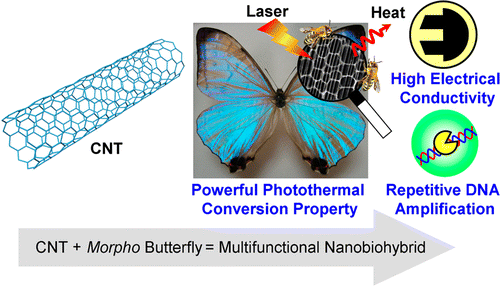Butterfly wings + carbon nanotubes = new 'nanobiocomposite' material

Leveraging the amazing natural properties of the Morpho butterfly's wings, scientists have developed a nanobiocomposite material that shows promise for wearable electronic devices, highly sensitive light sensors and sustainable batteries. A report on the new hybrid material appears in the journal ACS Nano.
Eijiro Miyako and colleagues explain that Morpho butterfly wings have natural properties that are beyond the capabilities of any current technology to reproduce artificially. In addition to being lightweight, thin and flexible, the butterfly's wings absorb solar energy, shed water quickly and are self-cleaning. Miyako's group had been working with tiny cylinders of carbon termed carbon nanotubes (CNTs), and became fascinated with CNTs' unique electrical, mechanical, thermal and optical properties. Miyako's team set out to marry the wings and nanotubes to produce an all-new hybrid material.
They describe growing a honeycomb network of carbon nanotubes on Morpho butterfly wings, creating a composite material that could be activated with a laser. The resulting material heated up faster than the original components by themselves, exhibited high electrical conductivity and had the ability to copy DNA on its surface without absorbing it. "Our present study highlights the important progress that has been made toward the development of smart nanobiomaterials for various applications such as digital diagnosis, soft wearable electronic devices, photosensors, and photovoltaic cells," the scientists state.
More information: "Self-Assembled Carbon Nanotube Honeycomb Networks Using a Butterfly Wing Template as a Multifunctional Nanobiohybrid" ACS Nano, Article ASAP DOI: 10.1021/nn403083v
Abstract
Insect wings have many unique and complex nano/microstructures that are presently beyond the capabilities of any current technology to reproduce them artificially. In particular, Morpho butterflies are an attractive type of insect because their multifunctional wings are composed of nano/microstructures. In this paper, we show that carbon nanotube-containing composite adopts honeycomb-shaped networks when simply self-assembled on Morpho butterfly wings used as a template. The unique nano/microstructure of the composites exhibits multifunctionalities such as laser-triggered remote-heating, high electrical conductivity, and repetitive DNA amplification. Our present study highlights the important progress that has been made toward the development of smart nanobiomaterials for various applications such as digital diagnosis, soft wearable electronic devices, photosensors, and photovoltaic cells.
Journal information: ACS Nano
Provided by American Chemical Society




















